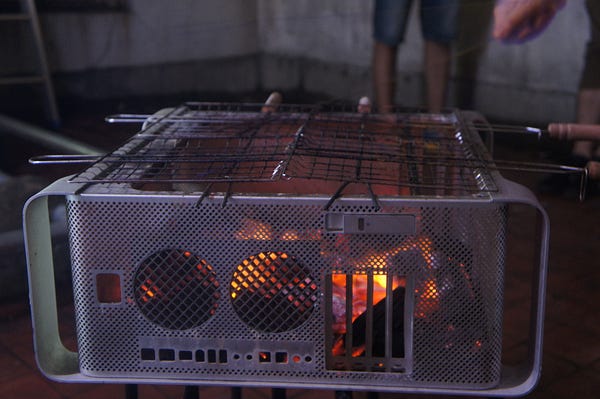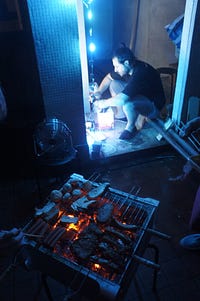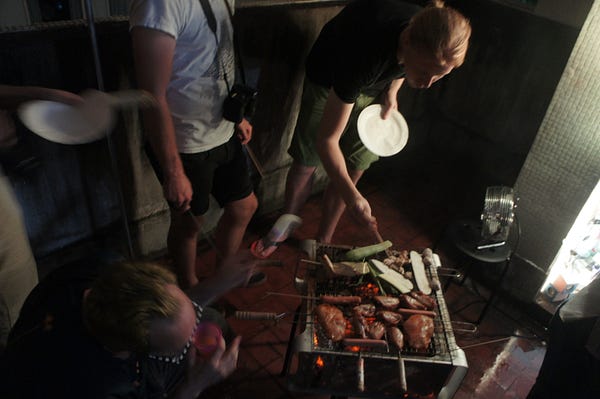
Shenzhen has been a pretty wacky experience. As soon as we got out of the subway station, we were literally greeted by a dance troupe. At first it seemed like maybe they were just street performers or just practicing for some cheerleading competition, who knows, big city, right? Except it was a pretty empty part of town and we were the only audience. And after they finished dancing they took a picture with us and walked away. It was super bizarre and disorienting and at the same time effective at welcoming us to the everything-will-happen attitude of Shenzhen.
The luxury tour bus provided by Tsinghua university was a big step up from taking the subway everywhere in Hong Kong, although it was always a little unnerving having little information on what the plan was, where we were going, how long we were going to be on the bus, that was always a mystery.
Basically, a cheerful woman meets us at the subway station and says she has a bus for us outside, and we gladly duck into the air conditioning. She welcomes us to China and introduces us to her co-workers (tho at this point we don’t know anything about her company) and one of her coworkers sings a song a capella over the bus’s PA. OK. We spend an hour driving on the highway through the city and the scale of this place become apparent. Unlike every other city I’ve been in where you drive out of the city center and the building get shorter, it seems that pretty much any residence here is required to be 40 stories high. Just endless high rises, with new ones being constructed right beside them. The only way you know you’re ‘downtown’ is when the high rises are covered in animated LED displays.
So we make it to Harbor School after weaving our way through a construction site with big signs for ‘special economic zone’ and I’ve written a separate blog about it cause it was awesome:
https://medium.com/p/e3bae07d8be7

And afterwards we had dinner at a great hot pot place, all paid for by our hosts (again, still unclear at this point on why they were treating us so well and who they were. Like I’m sure it was mentioned but I don’t know the name of any of the companies so it didn’t stick.) The next day it became more clear who are hosts were as we toured their factories that are owned by a company that has a partnership with the university. I’ll blog more about the factories separately, but after a few factory tours we ended up at this place:




It’s the showroom for this company 3Nod, and it took a while to figure out what the company did. The 3D room sized screen intro video communicated that they were all about creating a better future (implication: for wealthy people who live in spaceships). But the showroom was full of bluetooth speakers and headphones. Their vision of a smart home was just projector walls (a la Fahrenheit 451, surrounded by TVs…) I liked the style of the furniture, though one of my compatriots pointed out that they’d be pretty useless in practice, unless you can do all of your work via touchscreen.
Also the lights kinda clicked on and off without warning, the screens seemed to react to your gestures but didn’t do a great job (cause it’s Kinect based and it’s unreliable and everyone moved on from arm-wavey-HCI decades ago) so it seemed like their vision of the future was full of glitches and really needless technology stacks. There’s four projectors for that one wall. That’s like 2kW to have a bamboo forest by your couch. It would literally take less energy to just grow bamboo in your living room.
I really liked the couch tho.
Anyway we briefly met with Richard up in his office full of cigars and brandy. Very hollywood personality and attire. He kind of just pitched his company and his personal story to us without any context of why he’d invited a bunch of hackers/makers for a tour. He wanted to meet with Mitch and suggested the rest of us continue a tour of the building and hang out in his office on the top floor where he entertains. So there we were, a dozen idealists walking around gawking at this guy that makes his millions selling headphones with Wil.i.am. Alex took on entertaining us with piano and Jona performed a Chinese tea ceremony.
I noted that even surrounded by ostentatious wealth, sitting on plush couches, people still turn to their smartphones when they’re bored. Nothing all that exciting about it.
Ah, but no one is checking their phones in this last photo — we caught a ride to ShenzhenDIY. Well, the bus got us to the neighborhood but didn’t want to go onto the skinnier streets, so it was a nice walk. First past bustling markets with flashing LED and neon signage, electric bikes and mopeds weaving through people crossing the street, then through a dark alley with unfinished pavement such that a flashlight was necessary not to trip. Up a few flights of stairs in an old concrete building that I later learned housed a clothing factory and a Japanese sword factory (wait what?) we made it to the first real hackerspace of China, a tight community of people excited to meet visitors and share projects and passions. A DIY car chassis sat behind a comfy couch. Guitars and mixing boards sat against the wall. People passed around the microchips they were excited to write programs for. We went in a circle introducing ourselves and an expat member of the space announced in surprise that he is also from San Antonio, and he has never been in a room with so many Texans in China (two people in our tour group in the same room, pretty easy record to beat!)

A couple of friends and I went back the next day thanks to Yuheng opening the space for us to take advantage of the wifi and air conditioning. Here’s his github. He told us he’s writing a programming language with formal syntax to prove logical theorems (it won’t but the first, but it’s still an awesome project to write your own language). He was also interested in the design of spoken languages and introduce me to Toki Pona, an invented language of 120 words. He told us this was the first time he had a conversation with people speaking English which really surprised us and we asked how he learned, he said just talking along with American TV and movies. He also played a pretty mean Nirvana cover with one of the hackerspace’s guitars. Very inspiring dude.
Oh and this is the hackerspace that opened a second space at Harbor School, so they’re reaching out to the wider community and just being awesome.
















































































